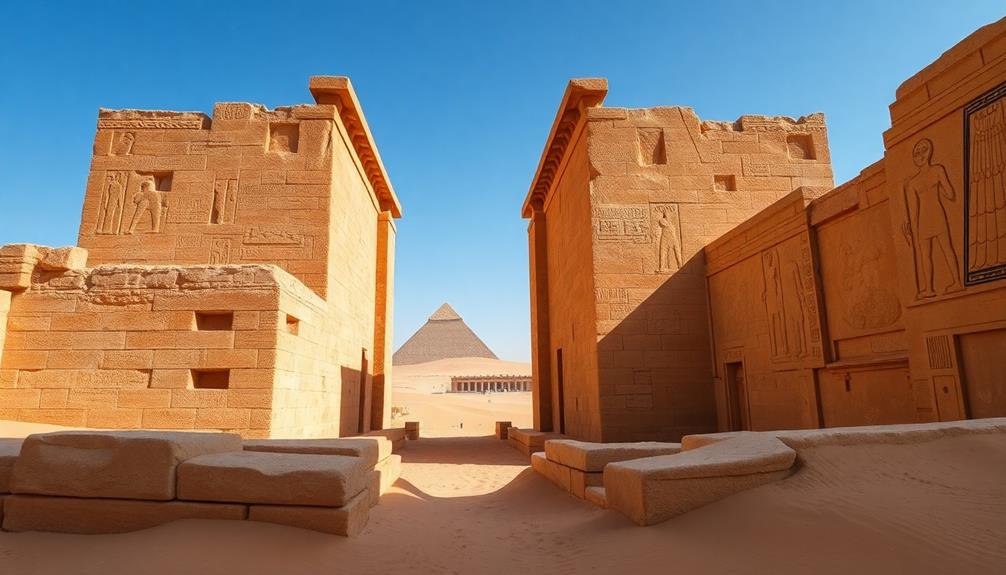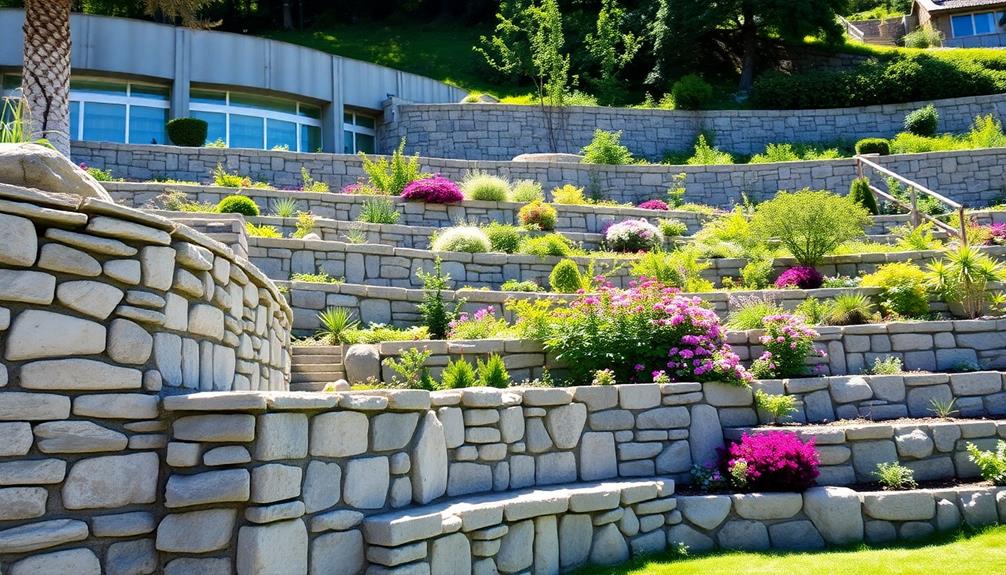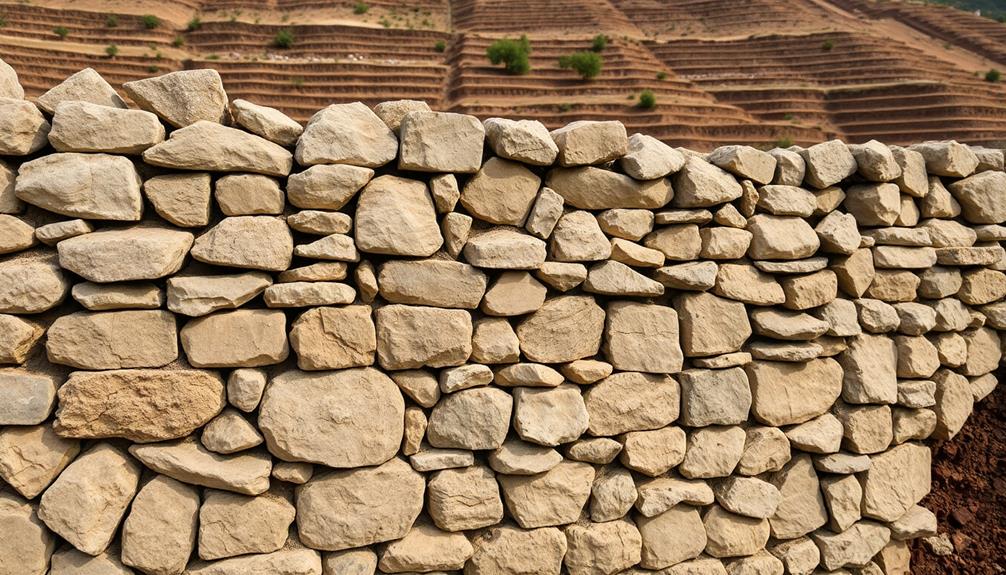Retaining wall construction and maintenance have evolved profoundly since ancient Egyptian stone fortifications. Early structures utilized dry-stone masonry and mortared techniques, employing locally-sourced materials like limestone and sandstone. The 19th century saw the introduction of reinforced concrete, while the 20th century brought innovations such as gabion cages and reinforced earth techniques. Modern retaining walls incorporate geosynthetic materials and advanced engineering principles, enhancing stability and longevity. Maintenance strategies have progressed from basic repairs to thorough approaches involving routine inspections, vegetation management, and structural upgrades. As regulations and sustainability considerations continue to shape the field, retaining wall design and construction methods adapt to meet evolving challenges and environmental concerns. Further exploration reveals the intricate details of this architectural evolution.
Table of Contents
ToggleWalls Contractor Highlights
- Ancient civilizations like Egypt pioneered retaining wall construction using stone masonry and advanced engineering techniques.
- Traditional materials evolved from stone and brick to reinforced concrete and geosynthetic-reinforced structures.
- Maintenance practices developed from basic repairs to comprehensive strategies including routine inspections and preventive measures.
- Engineering principles advanced to incorporate soil mechanics, drainage systems, and computer modeling for optimal design.
- Construction methods progressed from manual labor to mechanized techniques, improving efficiency and expanding design possibilities.
Ancient Egyptian Stone Fortifications

Ancient Egyptian stone fortifications stand as enduring chronicles to the engineering prowess of a civilization that flourished over four millennia ago. The construction of these monumental structures involved intricate processes, from the quarrying and transportation of massive stone blocks to the implementation of advanced building techniques using materials readily available in the Nile Valley.
Much like retaining wall designs today, the Egyptians applied sophisticated methods that catered to both structural integrity and aesthetic appeal. Despite the passage of time, many of these fortifications have survived, thanks in part to the Egyptians' meticulous maintenance practices and modern restoration efforts that continue to preserve these architectural marvels for future generations to study and admire.
Quarrying and Stone Transportation
The quarrying and transportation of stone for ancient Egyptian fortifications were monumental undertakings that required advanced engineering and logistical skills. Massive limestone blocks were extracted from quarries using copper chisels, wooden wedges, and bronze saws. These blocks, often weighing several tons, were then transported across vast distances to construction sites.
The Egyptians employed sophisticated techniques to move these colossal stones:
- Wooden rollers and sleds facilitated movement across desert terrain
- Specially constructed ramps allowed for vertical transportation
- Nilotic barges transported stones along the river, utilizing the annual flood
The coordination of these efforts demanded meticulous planning and a hierarchical workforce. Skilled artisans, under the supervision of master builders, worked alongside thousands of laborers to execute these grand projects.
The successful completion of these fortifications not only provided physical security but also served as an enduring legacy to the pharaoh's power and the nation's collective strength.
This shared endeavor fostered a sense of unity among the ancient Egyptians, as they witnessed the fruits of their labor materializing into impregnable strongholds that would stand for millennia, safeguarding their civilization against external threats and cementing their place in history.
Construction Techniques and Materials
Building upon the foundation of carefully quarried and transported stones, Egyptian engineers employed a variety of sophisticated construction techniques to erect formidable fortifications. These ancient builders utilized a combination of dry-stone masonry and mortared construction, depending on the specific requirements of each structure.
The dry-stone method involved meticulously stacking and fitting stones without mortar, relying on the weight and precise placement of each block to create a stable wall. For additional strength, engineers often incorporated a technique known as "coursed rubble," where larger stones were used to form the outer faces of the wall, while smaller stones filled the interior.
In areas requiring enhanced durability, Egyptian craftsmen employed lime mortar to bind the stones together, creating a more cohesive structure. This mortar, made from crushed limestone and water, was applied between courses of stone to increase stability and weatherproofing. The builders also implemented advanced engineering principles, such as battered walls that sloped inward to improve structural integrity and resist lateral forces. These techniques, combined with the use of local materials like limestone and sandstone, resulted in resilient fortifications that have endured for millennia, enduring evidence of the ingenuity of ancient Egyptian engineering.
Maintenance and Restoration Practices
Regularly, Egyptian engineers implemented thorough maintenance and restoration practices to certify the longevity of their stone fortifications. These practices involved meticulous inspection, repair, and reinforcement of the structures.
Engineers conducted periodic assessments to identify areas of weakness, erosion, or structural compromise. They employed sophisticated techniques to address these issues, including the replacement of deteriorated stones, repointing of mortar joints, and the application of protective coatings to shield against environmental factors.
The restoration process often incorporated advanced engineering methods, such as:
- Utilizing specialized tools and equipment to carefully extract and replace damaged stones
- Implementing innovative drainage systems to mitigate water damage and erosion
- Applying cutting-edge preservation techniques to maintain the structural integrity of the fortifications
These maintenance practices not only confirmed the continued functionality of the fortifications but also preserved their historical and cultural significance. By adhering to these rigorous protocols, Egyptian engineers fostered a sense of pride and continuity within their communities, safeguarding these monumental structures for future generations. The dedication to preserving these fortifications reflected the Egyptians' deep-rooted connection to their architectural heritage and their commitment to maintaining the strength and security of their civilization.
Benefits

Retaining walls offer a multitude of benefits that extend beyond their primary function of holding back soil. These structures greatly increase usable land area by creating level surfaces on sloped terrain, while simultaneously preventing soil erosion and stabilizing landscapes in areas prone to shifting ground.
Additionally, retaining walls provide essential structural support for buildings and infrastructure. In addition to these functions, boulder walls also enhance the visual appeal and curb appeal of a property in a way that complements the surrounding landscape. Retaining walls can dramatically enhance property aesthetics through their diverse design options and ability to create visually appealing terraced landscapes.
Increased Usable Land Area
One of the primary benefits of constructing retaining walls is the significant increase in usable land area they provide. By effectively managing slopes and preventing soil erosion, retaining walls transform previously unusable terrain into valuable, functional spaces. This expansion of usable land has profound implications for property owners, developers, and communities alike.
Retaining walls allow for the creation of:
- Terraced gardens, enhancing both aesthetics and agricultural potential
- Level building sites in hilly areas, expanding construction possibilities
- Expanded parking areas or recreational spaces in sloped landscapes
The ability to maximize land use through retaining wall construction has been an essential factor in urban development and landscape architecture throughout history. By stabilizing hillsides and creating flat surfaces, these structures have enabled the growth of cities in challenging topographies and facilitated the efficient use of limited space in densely populated areas.
Additionally, the increased usable land area provided by retaining walls has contributed to the preservation of natural landscapes by allowing for more compact development, reducing the need for urban sprawl and protecting valuable ecosystems from unnecessary encroachment.
Soil Erosion Prevention
A critical function of retaining walls is their ability to prevent soil erosion, offering numerous benefits to both the environment and property owners. These structures effectively combat the relentless forces of nature that can gradually wear away landscapes, safeguarding valuable topsoil and maintaining the integrity of surrounding ecosystems. By stabilizing slopes and hillsides, retaining walls mitigate the risk of landslides and soil displacement, which can have devastating consequences for both natural habitats and human-made structures.
The erosion control provided by retaining walls extends beyond mere aesthetic preservation. These barriers play an indispensable role in maintaining water quality by reducing sediment runoff into nearby streams, rivers, and lakes. This protection is particularly essential in urban and suburban areas, where increased impervious surfaces exacerbate the potential for erosion during heavy rainfall events. Additionally, retaining walls contribute to the overall stability of foundations for buildings and infrastructure, ensuring longevity and safety for communities.
Enhanced Property Aesthetics
Beyond their functional capabilities, well-designed retaining walls serve as striking landscape features that enormously enhance property aesthetics. These structures can transform ordinary outdoor spaces into mesmerizing environments, adding depth, texture, and visual interest to gardens, yards, and commercial landscapes. By incorporating diverse materials such as natural stone, brick, or decorative concrete, retaining walls can complement existing architectural styles or create a unique focal point.
The aesthetic benefits of retaining walls include:
- Creating multi-level garden spaces that showcase a variety of plants and flowers
- Providing a backdrop for outdoor living areas, enhancing the sense of privacy and intimacy
- Introducing vertical elements that break up monotonous landscapes and add visual intrigue
Professionally constructed retaining walls can greatly increase property value by improving curb appeal and overall landscape design. They offer homeowners and property managers the opportunity to maximize usable outdoor space while simultaneously elevating the visual appeal of their surroundings. When designed with careful consideration of color, texture, and form, retaining walls seamlessly integrate with the natural environment, creating a harmonious and visually pleasing landscape that reflects the property owner's taste and style.
Structural Support Provision
Fundamentally, retaining walls serve as essential structural support elements in landscaping and construction projects. These structures are engineered to withstand the lateral pressure of soil, providing stability to slopes and preventing erosion in areas with significant grade changes. By effectively managing soil movement, retaining walls enable the creation of usable space on otherwise challenging terrain, allowing property owners to maximize the potential of their land.
The structural support provided by retaining walls is particularly valuable in urban environments, where space is at a premium. These walls facilitate the construction of multi-level landscapes, terraces, and raised planting beds, effectively increasing the functional area of a property. In residential settings, retaining walls can transform steep hillsides into tiered gardens or create level surfaces for patios and driveways.
For commercial and industrial applications, they play a vital role in site preparation, supporting foundations, and safeguarding infrastructure from soil pressure and water damage. The implementation of properly designed retaining walls not only guarantees the longevity and stability of constructions but also contributes to the overall safety of the built environment, mitigating risks associated with landslides and soil subsidence.
Layering Techniques for Stability

Layering techniques are critical for guaranteeing the long-term stability and performance of retaining walls. A well-constructed retaining wall incorporates multiple layers, each serving a specific purpose in the wall's overall structural integrity and functionality. The following table outlines three essential layering techniques: proper soil compaction methods, geotextile fabric applications, and the importance of a drainage layer.
| Technique | Purpose | Implementation |
|---|---|---|
| Soil Compaction | Prevents settling and safeguards wall stability | Compact soil in 6-8 inch lifts using mechanical compactors |
| Geotextile Fabric | Separates soil layers and prevents material migration | Install between backfill and drainage layers |
| Drainage Layer | Manages water flow and reduces hydrostatic pressure | Place gravel or crushed stone behind wall blocks |
Proper Soil Compaction Methods
How can proper soil compaction methods enhance the stability of a retaining wall? Effective soil compaction is indispensable for creating a solid foundation and reducing settlement, which in turn minimizes the risk of wall failure. By systematically compressing soil particles, engineers can markedly increase the soil's density, load-bearing capacity, and resistance to water infiltration.
This process typically involves using specialized equipment such as plate compactors, rammers, or vibratory rollers to achieve perfect soil density in layers.
To ensure proper soil compaction, professionals adhere to the following best practices:
- Carefully control moisture content to achieve maximum density
- Compact soil in thin lifts, typically 6-8 inches thick
- Perform regular density tests to verify compaction meets specifications
These methods not only enhance the wall's structural integrity but also contribute to its longevity and performance. By meticulously implementing proper soil compaction techniques, engineers and contractors create retaining walls that stand the test of time, providing lasting safety and stability for surrounding structures and landscapes.
This attention to detail in the construction process fosters a sense of security and belonging for property owners and community members alike, knowing their infrastructure is built on a solid foundation.
Geotextile Fabric Applications
Incorporating geotextile fabrics into retaining wall construction dramatically enhances stability and longevity. These synthetic materials, when strategically layered between soil and aggregate, form an essential component in modern retaining wall systems. By implementing geotextile fabrics, engineers and contractors can greatly improve soil reinforcement, drainage capabilities, and overall structural integrity.
The layering technique involves carefully placing geotextile sheets at predetermined intervals within the backfill material. This process begins with the installation of a base layer directly behind the retaining wall face, followed by subsequent layers as the wall height increases. Each layer of fabric acts as a stabilizing element, distributing loads more evenly throughout the soil mass and preventing localized stress concentrations.
Additionally, the permeable nature of geotextiles facilitates proper water drainage while retaining soil particles, effectively mitigating hydrostatic pressure buildup behind the wall. This dual functionality of reinforcement and filtration contributes to the longevity of the retaining structure, reducing the risk of failure due to erosion or excessive soil movement. As a result, geotextile fabric applications have become an indispensable aspect of contemporary retaining wall design and construction methodologies.
Drainage Layer Importance
Essential to the longevity and stability of retaining walls, proper drainage layering techniques play a pivotal role in preventing water buildup and soil erosion. As early as the 19th century, engineers recognized the importance of incorporating drainage systems into retaining wall designs. These systems typically consist of a permeable layer of gravel or crushed stone placed behind the wall, complemented by perforated pipes to channel water away from the structure.
The significance of drainage layers in retaining wall construction cannot be overstated:
- Mitigates hydrostatic pressure, reducing the risk of wall failure
- Preserves soil stability, preventing settlement and erosion
- Extends the lifespan of the wall by minimizing moisture-related deterioration
As construction techniques evolved, the integration of geotextile fabrics with drainage layers became standard practice. This combination enhances filtration capabilities, preventing fine soil particles from clogging the drainage system while allowing water to pass through freely. The implementation of these advanced layering techniques has greatly improved the performance and durability of retaining walls across various applications, from residential landscaping to large-scale infrastructure projects.
Walls Contractor FAQ
What Are the Environmental Impacts of Modern Retaining Wall Construction?
Modern retaining wall construction can impact ecosystems through soil disturbance, habitat disruption, and potential runoff issues. However, sustainable materials and designs are increasingly being adopted to minimize environmental footprints and promote harmony with surrounding landscapes.
How Do Seismic Considerations Affect Retaining Wall Design and Maintenance?
Seismic considerations fundamentally influence retaining wall design and maintenance. Engineers must account for lateral earth pressures, soil-structure interaction, and dynamic loads. Regular inspections and reinforcement strategies are indispensable to guarantee wall stability during earthquakes, protecting our communities from potential harm.
What Are the Cost Differences Between Various Retaining Wall Materials?
Cost differences between retaining wall materials vary considerably. Concrete is often more expensive initially but durable. Wood is cheaper but requires more maintenance. Gabion and stone can be cost-effective alternatives, depending on local availability and labor costs.
How Often Should Retaining Walls Be Inspected for Structural Integrity?
Regular inspections are essential for our retaining walls. We should conduct visual checks annually and thorough structural assessments every 3-5 years. This guarantees we maintain safety and catch potential issues early, protecting our investments and community spaces.
Can Retaining Walls Be Retrofitted to Improve Their Performance or Appearance?
Yes, retaining walls can be retrofitted to enhance both performance and aesthetics. Our community often embraces such upgrades, which may include adding drainage systems, reinforcing structures, or applying decorative finishes to improve appearance and functionality.







